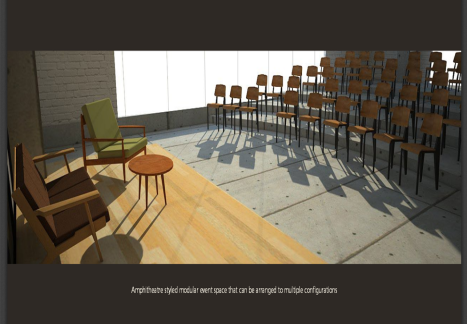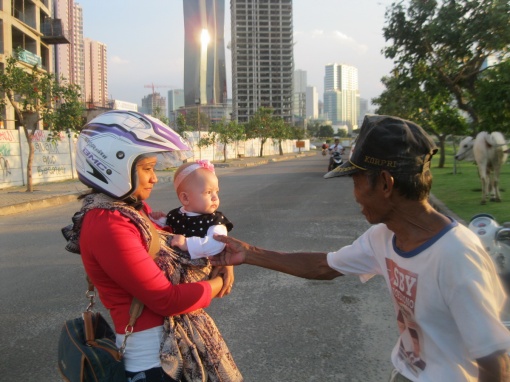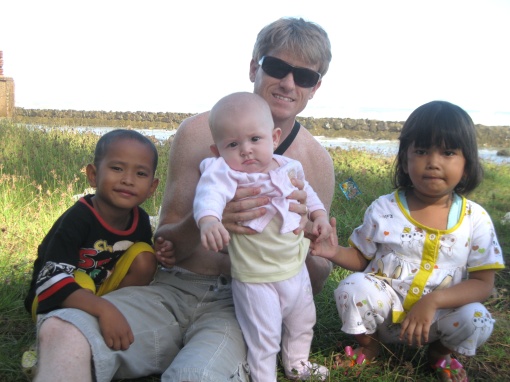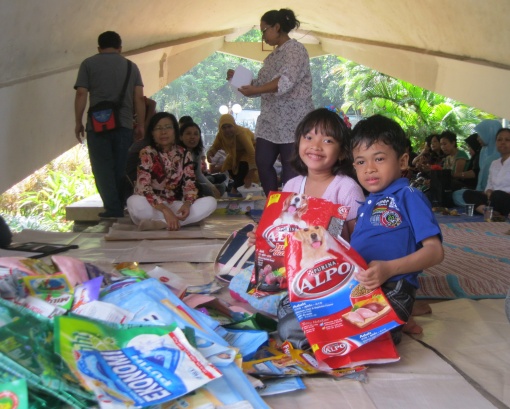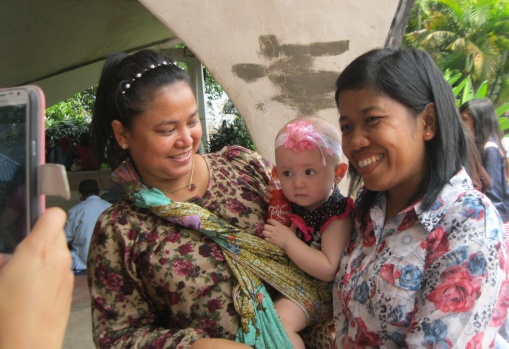Part of Jakarta
Concrete communities of Indonesia: Coworking is the new sharehouse
So you’ve heard about Hubud and Comma. But how about Conclave? Open 24/7, massive windows, showers, and a workshop where you can hammer, drill and grind stuff.
A fitness club for your career married to a library and an internet cafe — hubs and coworking ventures are kinky, hybrid creatures. They’re inspired by the free-wheeling work culture of the Silicon Valley startup scene (traditional hub at Stanford University).
Co-operation. I love that. Even the hyphen. My operation. And yours. Grinding merrily along at 3:00 a.m., enveloped by the magic mists of central Bali or the hipster haze of South Jakarta.
To join the hubbub click any of the graphics below.
Leftover Learning: Peer-Coaching for Indonesian Domestic Workers
 I interviewed Nanny Tini, the “Beverly Hills Nanny,” a couple years ago. This time she introduced me to a few friends.
I interviewed Nanny Tini, the “Beverly Hills Nanny,” a couple years ago. This time she introduced me to a few friends.
TWO neatly-dressed children frolic in a pile of empty coffee sachets and laundry detergent pouches.
Maids, cooks, nannies and a few gardeners and drivers remove their shoes and sit down on plastic sheets in a shady spot outside the entrance to the Jakarta zoo.
Collide-a-scope jakARTa : we’ll leave the (brake) light on for ya
This gallery contains 12 photos.
This enormously important photo installation was created using a Zoda bottle, a string of leftover Halloween lights and my trusty and literally rusty 12 MP Canon Power Shot, a virtually indestructible device. (So the bottle is like a hand-held diopter. You can leave a little water in the bottle and then you point it at […]
Expate, outsource, automate and disappear: how to spend less and live more in Indonesia
Here’s what we’ve heard over the years about why single expats find that sharing a house near the business district with other expats makes sense in a city like Jakarta.
“I like the fact they’ve got a micro-brewery on board. It’s social, but in a focused way. The Jakarta serviced apartment thing was convenient, but ultimately alienating and boring. There’s just not that much going on in Jakarta on the 26th floor.”
— Development consultant, Madrid
“The kost thing was fun for a while. Sure you meet a lot of people, including Indonesians. It’s almost like a family experience. But then if your boyfriend comes to Indonesia or something . . . or you want to throw a Halloween party, you may as well be in a hotel . ”
— Tech journalist, Palo Alto
“My company offered me a big kontrakan [rental house]. But there were a lot of questions about who was going to look after it. I’d just as soon not have a pool if I have to clean it.”
— Expatriate GM, Melbourne
“I’m having enough trouble with my driver so I wasn’t really keen on having more people [maid] to manage.”
— Hydro engineer, Montreal
“Once I got the gym membership and located a few good swimming pools, there was really no reason to stay in the apartment.”
— Intern, Helsinki
Dish jockey: Who says housework is drudgery?
This gallery contains 10 photos.
I made this by pointing my cell phone at an aluminum bowl with a little water sitting in a pot in the sink in the kitchen. – Yes, you need to slosh the water around a little bit so that it’s in motion. But the secret is to always hang those cheap red, blue, yellow green LED […]
Get ready, get set, GoPro Jakarta
Here’s me and #babygirl getting ready to roll. The first, but not the last, Hero3 footage I’m uploading.
Ironically, if you’re like me and live in Indonesia, then you can’t view this Vimeo footage because, for reasons we don’t understand, Vimeo for several months has been blocked in Indonesia. Because it’s a porn site, you know. For reasons we don’t understand.
Wake up, it’s night in Jakarta
Night time is basically the right time in Jakarta — because it’s cooler, quieter and less congested. You can get a lot of stuff done at night. A night watchman can help set the tone.
Yes, we have vacancy.
Little girl dreams about farms, fairy tales and flying tigers
As we come closer to reverse engineering our own brains questions like this come up:
When we look at a glass of iced water, we perceive the liquid and the solid ice cubes as independent things even though they are intimately linked as part of the same system. How does this happen? Out of all possible outcomes, why do we perceive this solution?
No clue and I’ll raise you one: When do we begin to perceive that the liquid and solid ice cubes are dif? Because, guess what — I don’t think every baby does. In fact, just betcha that when they’re really little, kids see stuff a lot cooler than when they get older. Dr. Seuss and Sasha Shulgin (1925 – 2014) cool. Like liquid ice.
I mean, nobody knows what babies dream — right. Or toddlers. Just look at all the crazy illustrations below for some artists’ impressions. Because arguably the reason we tell kids fairy tales is because no one else would believe them. It’s obviously part of the process of peeling the water away from the ice cubes and getting your reality on.
Life starts in the barnyard, correct. My daughter, for example, knows very well that “horses like hay and goats like to play” — even though she’s only seen a couple actual horses, no goats, a few cows, the odd flock of wild turkeys. Because she’s into it — Massey Fergusun tractors, anthropomorphic scarecrow technology, old-school cowbells — all the stuff. Very basic, you say. But look how young you (probably) got involved yourself. So, yea, it would seem basic.  Continue reading
Continue reading
Shut down & off the hook: Jakarta Car-Free Day photos (every Sunday a.m.)
So these are the best pics I could find of “Car-Free Day” which is when they shut down 5 miles or so of the downtown every Sunday a.m. for jogging, biking and just hanging out. Oh yea. And one pic of “Car-Free Night,” just in case.
So the earlier you go the cooler it is. If you later, it’s hotter as well as less cool. Bring your camera. This may be the only time you see adult Indonesian women wearing shorts, err …
Dump old spice and other tips for Indonesian cooking
After 500 years on the global #spice map, Jakarta is one gourmet -friendly city. This post is about how to make the spicy goodness of Indonesia work for you.
Remember how you turned onto Indonesia? Was it about cooking? Food? Spices? Are we getting warmer?
We really are getting warmer, ’cause this Indonesian spice and herbal thing has begun to heat up. It used to be you could go for years in Indonesia without anyone making a big deal about spices. Because, after all, we’re talking about the Spice Islands where people demand savory food. But recently you see more restaurants catering to locals as well as expats that invoke the East Indies’ spicy history.
After all, this is where even the poorest of the poor awake before dawn to spend hours grinding weeds and seeds into a savory base used to spark a flavorful paste to season a sauce which may just be one of the key ingredient of — shall we say — a dumpling . . . to be elaborated over the course of hours or days, together with other exotic and disparate elements — some fresh, others not, into a “simple” traditional Indonesian dish like siomay.
And not to miss the value added, in the take-away context, that’s going to come with three to five toppings and sauces, each individually-wrapped in leaves, plastic (and occasionally newsprint or recycled office paper). Depending on whether you ordered fish, fowl or neither, the toppings will range from dried onions and tiny chili peppers (eaten raw, as in Mexico) or shredded coconut, raw cane sugar, etc. Among the most common optional sauces you’ll to choose from a soy-based one, a peanut number, a spicy one — a million more but I forget them and can’t describe them at all in any language, but no reason to chose either, have them all, it’s included. And that’s how we make two-for-a-buck street food around here.
While the glut of fast food and convenience stores that has accompanied the explosion of middle-class Indonesian consumerism over recent years will surely take its toll on the Indonesian palette sooner or later, for now I see peeps sticking fairly close to their culinary roots and, I might add, bark, leaves, stalks and stems.
Yet buying spices in Jakarta is perhaps easier written about than done. Fact, is there’s a couple missing links in the supply chain. Women who grew up shopping at a traditional or village market (AKA wet market or pasar tradisional) and producers who used to sell there are now wandering around Carrefour, Ranch Market, and Hero looking for each other. But things are sorting themselves out fast and what I’ve seen over recent years mushrooming options and falling prices.
Language and labeling is also a challenge. Indonesian has many words for spice (rempa-rempa, bumbu, or hasil bumi) and yet for the most part cooking know-how is coded in regional languages like Sundanese, Javanese, etc. — not Indonesian. So sometimes it’s hard to hunt down spices that are actually here in Indonesia, let alone trying to substitute your way to French, Italian, Mexican or other gourmet greatness while based in Jakarta. It’s possible, but requires patience, as do special spice/herbal applications such as for diet, detox, jamu (traditional medicine), essential oils (minyak astriri), aromatherapy or other purposes.
Be as creative as possible because there’s a lot to (un)learn. Basically, the gist of it is to demand more from the Indonesian spice experience. Just think: if you can get the most essential oils at the mall in Melbourne and the sexiest of shallots in San Fransisco, then it ought to be that much better here Jak, especially once you factor in prices. Right?
If you want to make this work, do yourself a favor and drop the “gingko is for grandpa” and “hops is for beer” riot upfront. Hops is a brilliant sleep aid and, while the gingko research is ongoing, so far we know that it works for young and old men and women — at least for sex (get blood flowing several places).
It’s important to know the horticultural, historical background and cultural context for spices — like nutmeg and mace are the same species; black pepper and chili pepper aren’t related; and green/Bell peppers (which Indonesians, Dutch and others call paprika) and chili peppers are related.
And what about “old spice”? Just dump it. Ground nutmeg, ground black pepper, and whole cinnamon bark ,just to name a few, very frequently have funky stuff growing in or on them, or a funky smell, after just a few months of sitting in the spice rack in Jakarta. And sometimes the funky junk is already present when you purchase them at the store. I picked up some Mr. Boemboe dried basil that was infested with tiny beetles the other day and you can often see the little worm folk doing a Swiss cheese number on the nutmeg seeds while they’re still on the shelf at the supermarket.
Here’s some more Indonesian spice advice:
- Start with the basics and focus on one spice/species (same root) at a time. As you might expect with kitchen science, it’s about building blocks and baby steps. So, learn as much as you can about varieties, sources, quality and uses of one plant. Some of the most rewarding phytonutrients sources, mood changers and sex pals are roots, shoots, weeds and seeds you already know and love — coffee (biji kopi), tea (daun teh), ginger (jahe), tumeric family (kunyit), chili pepper (cabai), cinnamon (kayu manis), coriander (ketumbar), cloves (cengkeh) and pepper (biji lada) — sorry, for the short list. That last one, BTW, is (indirectly) how we ended up with the piperizine family of chemicals, including everything from antidepressants to pepper spray weapons.
- Get some simple tools like the mashing stones, some mesh wire for drying things, a kitchen scale, etc. Now go buy some cinnamon sticks and make sure your outfit is robust enough to reduce them to a fine powder.
- Re-task the maid from the ironing board to the kitchen to help with the unlearning process. Why not startw ith the bawang category (garlic and onions belong to this group), then move on to the non-pepper group which includes chili peppers (cabai), black pepper (lada) and green peppers (paprika). (See, even though in English the word pepper suggests a close relationship here, there really isn’t one.) Very soon you’ll remember from Anthropology 101 that food — especially spices — is entirely cultural. So, it’s really important not to say “as far as I know nutmeg is mostly for eggnog”; or “yea, I think everyone knows that tumeric is good for you.” Ask instead, why the hell were people killing each other over nutmeg and what can tumeric do for you today.
- Get in touch with your inner wet market. Sadly and despite a fairly solid traditional market lobby and even some well-intended regulations (which aren’t working), the traditional market may be on its last legs in Jakarta. And the situation is mirrored throughout Indonesia. (Yes, indeed — I’m talking about those horrendously freaky, leaky, smelly, dark concrete caverns where the maid buys veggies in the early a.m.)
But not to setres out, since something nearly as funky will surely take it’s place — just wait and see. If you’re near Block M, it’s already in place — that wet market has been relocated into a normal shophouse directly across from Blok M Square where it appears as a lovely “Asian produce” store. I suppose it’s resembles the original, more or less, except not as dark and cleaner and more user friendliness.
- Jump-start your upstream spice knowledge by growing an herb garden. The only reason Jakarta isn’t a huge hippie magnet is I guess that people can’t imagine a Muslim hippie (actually yuppie, because you pay a pretty premium locally for seedlings, soil, fertilizer etc). But I can tell you what the Indo hippie /yuppie reads and it’s Trubus. Anyway, no need to read. Nothing could be easier than gardening in Jakarta. But have an Indonesian help you with it, if possible, to increase local relevance.
- Reverse engineer a hot mug of jamu. Jamu is Indonesian herbal medicine and it’s so universal you may never have heard of it if you live in Indonesia. But people overseas know about Indonesian spice and once they’re get hooked on classics like ginger coffee fortified with love herbs or cajuput oil (little dab will do for aches and pains), hell with that revenue we may even be able to quit logging off the rainforests around here.
- Find the local herbals section/shelf of your favorite Jakarta pharmacy (AKA apotik) to see for yourself how it all starts coming together. Yes, there is some risk in shelling out hard-won rupiah on an obscure botanical product from an unknown outfit in Central Java, but mostly just cash you’re gonna lose if it sucks. The established cosmetic/spa/herbal makers (it’s a growth industry) lobby hard and the local press snoops pretty good on this one, to keep a good thing from going down the drain. There are exceptions, though. I would consume local/unknown essential oils a drop at a time only (build up gradually) and be very suspicious of whether or not cupid has figured out how to spike your pasak bumi (a relatively expensive natural aphrodisiac) with throw-away chemical sildenafil citrate (tell me if you need a ton, it’s also got some curious larger-than-life side effects ; )
- Go for a little ethnic flavor. Remember, Indonesian is a catch-all, not an ethnicity. Tap centuries of traditional Chinese medicine (TCM) wisdom in China town at bespoke, made-while-you-wait herbalist shops behind the electronics market (that spans both sides of the main drag) in Glodok. Or to to Pasar Baru for a little Indian touch. As for other go-now brick-n-mortal fix, you’ve got tons and growing retail options for spice/herbal/spa products at the mall these days (including Botani at Gandaria City). The grocers and fruiteers are also stocking more exotic natural teas, etc. There are also a couple people who do small scale wholesale and you can email me.
- Just keep clicking to learn and buy in large quantities. For instance here, on Nature’s Herb Form, you’ll find just about as much grass & oil info you’d ever need (local analog here if you’re pretty sure you’ve got the next-gen Coca-Cola almost market ready, check Indonetwork, Agromaret or even Kaskus for a wholesale hookup.
- Make it good, but not too good. Eggnog and beer are pretty good examples. Remember, as a patent medicine, Coke had non-secret ingredients cocaine and kola nut. Now only one of those is still legal and there’s pressure on the other. Then, during prohibition they had to quit putting alcohol in Coke. And now they’re forcing kids to drink it without caffeine some times. As always, however, it’s still flavored with nutmeg.
Bule Madura meets Kuningan cowboy
My Madurese-American daughter is only 8 months old, but she found the cows pretty impressive. Unlike elephants, which I think are a little too big for her to appreciate. But almost everyone who drives through this #partaJakarta stops to have a look at the cows.
I heard BSD group bought land here and is building two towers. Not sure where. Needless to say, the cows won’t be around too much longer. The cowboy will sell his land and his cows and, who knows, maybe move into a fancy apartment here in the #heartofJakarta.
But there has been so much rain this year I almost wish I had a couple out there myself. Tons of grass. Not at all like Madura, where this time of year it’s already dry as a bone in a lot of places — like #Bangkalan.

Tapi apa yg dia benar2 demen? Gerobak tukang kelapa: adem, tidak beresik, dan fans bangat kelapanya. Jadi lama2 kita cuekin anak2 main ombak dan kita main kelapa.
Friendly expat guesthouse in a classic Batavia-style neighborhood adjacent to the Jakarta business district
Calon Arang: The Lion, the Witch and the WordPress
Newer than the Odyssey and older than Hansel and Gretel? Beowulf of Bali? Am I warmer? Hotter?
Are tongues of flame leaping from my nostrils and my mouth, devouring banyan trees and instantly turning nearby soldiers to charred mounds of flesh ??
Friends, I really have no idea what to say about Calong Arang besides:
- she was a witch and her name seems to mean “ready to barbecue” (swear! best translation I can make/find)
- who practiced the blackest of magic and sacrificed kids to Durga
- it’s a seminal tale, about 1000 years old, remembered better perhaps in Bali than Java
- totally connected to Rangda (witch), Barong (the lion), and trance dance
- Pramoedya covered it in The King, the Witch and the Priest A Twelfth-Century Javanese Tale
- one of the first Indonesian films (1927) went there; but now it’s lost (not the 1985 one)
- crops up a lot in Indonesian plastic arts, wayang and theater
- Gregory Bateson, Margaret Mead and Hildred Geertz (once married to Clifford) are among the only folks who’ve managed to comment at all without wholesale copy-pasting Wikipedia and ripping off jpegs from DeviantART
So Hildred Geertz (it seems) pointed out that, in Bali, it’s real magic — not just a story about magic — and the costumes are a big part:
[N]otions that [it’s] just a story are dispelled on recognizing that … the play is a practical act of attack and defense in a world teeming with … invisible beings …. who are willful, irritable and easy to anger, but [can also] be … benevolent …. [I]n Balinese rituals, the masks and [the] play bring the spiritual beings into contact with humans where they can be … bargained with, entertained and even threatened.
Enacting a narrative such as Calong Arang is a means for communicating with these beings and one of the main channels are the masks themselves, for masks can be, in Bali much more than mere costumes [77].
Images of Power: Balinese Paintings Made for Gregory Bateson and Margaret Mead
I warn you, stick with Google images. No matter what language you speak you’ll find nothing relevant about this topic. And if you go to a performance titled “Calon Arang,” again, that’s like saying “Hansel and Gretel.” It could be almost anything.
Spooky, man. Real spooky 8 ]
Rare footage : Charlie Chaplin tramping around Indonesia
Young Indonesians who’ve seen Chaplin & Co on Indonesian TV might be surprised to know that Charlie Chaplin was a real guy — quite famous –who once romped his way through Indonesia in 1932. Even children in Batavia (now Jakarta) knew who he was back then.
Unfazed by modern times, kids in Bali in the 1930’s thought he was just another bule gila (crazy white guy). Although you’ll see he did manage to get some laughs.
Legong: Dance of the Virgins (1935), “authentic” Balinese love story
Legong: Dance of the Virgins (1935) was shot in Bali by big names of the day. While few people have ever seen it, it’s quite popular with those who have, including Bloom and Hagedorn. They relate that, upon “distribution by Paramount [some] scenes of nudity were trimmed for domestic release in the United States, and shots of cockfights were excised from the British prints.”
Dances with horses — from jatilan & kuda lumping to gangnam & merengue
Four-legged men and women, which are common in global mythology, prove the human-horse connection is an old one.
From Indonesia’s mystical and trance-linked jatilan (also jathilan) and kuda lumping, to the refined steps of the Korean gangnam style — the equestrian tradition remains an inspiration for choreographers and dancers.
Video below shows Indonesian horse spirit possession, although with horses rare in the archipelago, monkey spirit possession — being possessed by the spirit of a monkey– may actually be as common.
While in Indonesia trance dance is a time-honored way to put the whole village on edge, possession by the spirit of Janet Jackson (videos below) only began gaining popularity in the early 1980s (Jackson was born in 1966).
[youtube http://www.youtube.com/watch?v=Fxo_NMqq_YU%5D [youtube http://www.youtube.com/watch?v=ckSrsLW5df8&feature=related%5DA relatively uncommon hybrid form of Indonesian dance/drama: simultaneous possession by the spirit of Janet Jackson and a horse (unknown breed):
In the inimitable “merengue” idiom, here’s one from the inimitable Kinito Mendez:
[youtube http://www.youtube.com/watch?v=9moaJfKkFdY%5D
EDITOR’s NOTE:
Why yes, a little editorial horseplay may be involved, but all in good fun, and to celebrate the fact that #jathilan was recently deemed the “world’s worst art form” by the Bibit Waluyo, the governor of Central Java (where an estimated 500-plus jathilan dance troupes and groups). He said he didn’t mean it. Perhaps he was simply embarrassed by a bad performance. It’s just kind of a funny statement.
Jathilan and dance/performance traditions shows are truly on the weird end of the horse-play spectrum, but very popular here in Indonesia. Based on You Tube and Flickr, it looks pretty cool. So, I’m sure towns all over West Java, East Java and Malaysia will take the reins if Central Java decides it really is over the bamboo horse dance, after all these centuries. Bali separate but related forms of mane-ia and circumstantial evidence suggests the Madurese are also hot to trot.
PLEASE COMMENT or FOLLOW, especially the trance dance channel for objective information about trance dance and spirit possession in Bali, Java and Madura.
Kuningan Cowboy | Bovine Mobile Living
 Speaking of bullshit, there’s a friendly bapak who tends a small, co-ed herd of large cows in the “kampung” area between Menara Imperium and Taman Rasuna (behind KPK, not far from the Sharehouse). It used to be a swamp, then an empty grassy area and now it’s sprouting skyscrapers and most of the people who lived there (even had a mosque) are gone.
Speaking of bullshit, there’s a friendly bapak who tends a small, co-ed herd of large cows in the “kampung” area between Menara Imperium and Taman Rasuna (behind KPK, not far from the Sharehouse). It used to be a swamp, then an empty grassy area and now it’s sprouting skyscrapers and most of the people who lived there (even had a mosque) are gone.
“I’ve been shot, blogged and broadcast,” he told me, shaking his head. “And I ain’t got a single snapshot to show nobody.”
Tips for Managing Domestic Staff in Jakarta
I’ve revised my two-year old tips based on a couple more years of experience as well as a dozen underlying assumptions about what its like to employ and be employed within Indonesia’s “informal sector.” By the way, the Indonesian word I have in mind is pembantu — literally, “the help.”
These tips apply more to expat families who are in Indonesia for longer periods; who employ household staffers for a broader range of tasks; and who employ Indonesian at least some of the time for managing them. So if someone says they “could care less as long as the laundry is done” I suppose that’s fair enough.
Finally, I’m going to assume your housekeeper or hired help is female. In fact, that’s not always the case, please forgive me.
Tips for hiring household staff
- Indonesians say a domestic staffer (pembantu) should be jujur (honest) and kerja keras (hard working). Here are three more traits which ought to make sense to you no matter where you’re from (if you can guess what they are : ) inisiatif, kreatif, and berdisiplin.
- Try to find a happy medium between wait-and-see and make-the-shoe-fit while a new staffer is still on training and probation. It may be a disappointment to spend a lot of time only to determine she won’t work out. But it’s more likely to work if you go ahead and manage all those expectations early on.
- Make sure your staffers know that the traditional “thirteenth month” bonus system is in place (it should be). Making it work for 12 months is a reasonable goal on both sides.
- Working as a maid doesn’t require necessarily literacy (sure helps); but hiring one does. The basic terms of your maid’s employment, the agreed work calendar, and your expectations and notes about her performance should be written down, even if it’s just in a notebook sitting on the kitchen table.
- Can’t figure out why your maid works so hard? Possibility because you do; although the reverse could be true.
Tips for tasking and training household staff
- Does it work to have an interpreter, personal assistant or friend who also does your laundry? Maybe. But try to keep an eye on the “mission creep” and identify potential unhappy endings. Otherwise, hire an actual personal assistant so your maid can focus on the housework.
- Your maid likely isn’t trained as bank teller or accountant. Make things easy on yourself by not leaving valuables lying around or insisting she keep careful track of money. This is a waste of her time, especially in a paperless world like the traditional market. (I’m not saying to “let her keep the change,” which seems obviously a bad idea.)
- Keep track of the relative strengths and weaknesses of your staff and use this for tasking. The relevant skill set is broad; you could conceivably have a “maid” doing anything from gardening to nannying and you may choose to re-task instead of re-hire. Still, it’s hopeless to have someone who is spatially unorganized tidy the closet, etc.
- The day your staffer fails to show up is the day that you must not. A decision has to be made and communicated to everyone involved about what happened, why, what happens next, what happens next time, etc. Likely as not it really was flu, flood or funeral — just like she said. You did catch what she said, didn’t you? If not, ask for an SMS. Try to figure it out. This shouldn’t require much time nor should it be postponed too long. Tips for losing household staff
Tips for losing household staff
- Communicate as succinctly as possible how expectations weren’t met and follow up immediately with action, such as requesting return of keys, belongings, etc. It will be easier to fire your staffer if the expectations and communications are already there in the first place. This is not the time for “misunderstandings.”
- Don’t share the details. Third parties must be content to know that “she had to take some time off” and the confidentiality will generally be to the advantage of both household and staffer (especially if she reapplies in the future).
- Sometimes it really is easier to do it yourself: don’t be surprised to discover that a dozen household bugs are zapped the day your maid walks out. That’s why she’s gone, right? Then in three days when you’re sick-to-death of doing things the easy way and start interviewing again, don’t forget to share your best practices with the new maid.
- Someone you can’t trust who has access to your house should be released. But avoid paranoia. Install CCTV and do periodic security audits, including the servants quarters. But try not to worry about what happened to the Rp 20,000 you left in your pants pocket last Thursday. Whether it’s sneakiness or poor stewardship, being suspicious will undermine trust and worsen the situation.
- Aspects of Linquist’s best practices for terminating domestic staff may also be relevant.
Spacious sublease for expats avail. in Kuningan/Menteng (house)
 https://sharehouse.wordpress.com/faq/%5B/caption%5D
https://sharehouse.wordpress.com/faq/%5B/caption%5D
Yes, we have vacancies.
Monthly lease rates range from Rp 5 – 6 million with minimum 9-12 month lease including unbeatable location near Four Seasons, wifi broadband, newspapers and coffee on breakfast table, clean laundry in your wardrobe, hot showers, good pressure, cold AC, full kitchen, CCTV and on-premises security, and a microbrewery!
Email: sharehouse.jakarta@gmail.com
Cara bikin blog — tips & trips untuk blogger baru
Apa artinya blog?
Blog itu adalah : web + log, sedangkan sebuah log adalah buku hari-harian — seperti pakai kapten kapal. Sering kali kapten, penjelajah maupun ilmuwan berwajib mebuat buku catatan (log) — kecuali mau lupa/rugi/tabrak sekalian. Tapi siapa bilang semua blog mesti menarik atau keren. Tidak mesti. Semua tergantung.
Blog bukan rahasia malah umum dan publik. Jadi, jangan mencoba ngblog dalam isolasi. Silahkan ngcek duluh pendapatan orang sebelum posting. Kalau sudah di posting sama orang lain, tidak usah di ulangi — kecuali kurang jelas, tidak menarik, jadul, dll. Kalau emang begitu, silahkan di rapikan atau meperbarui aja. Dan jangan lupa kasih link kpd aslinya.
Kenapa post blog biasanya pakai link?
Karena kami ngblog dalam lingkungan publik sedangkan link adalah teknik untuk menujuk, seperti . . . . .>>>>ini (cara bikin blog WordPress) dan/atau ini (bedanya blog gado2 dan blog niche). Pemakaian link bisa menciptakan konteks, kredibilitas dan kedalaman secara cepat.
Yakin gak orang akan membaca posting saya?
Sebenarnya, pembaca anda yg pertama dan utama selalu menjadi Google, Yahoo, dll. Jika Google suka blog anda, dewa itu akan di promosikan, secara tidak dikubur lagi dibawa konten orang lain. Setelah itu, pasti orang datang. Jangan lupa: Google menyukai tulisan yg menarik, terfokus dan unik. Tidak usah rumit atau canggih – sederhana juga okey. (Tentu, Google senang juga kalau pakai foto yg menarik, unik dan berkualitas.)
Apa saya mesti modalin banyak waktu untuk memiliki blog bagus?
Beberapa aset dan keterampilan yg relevan untuk anak blogger: mata utuk theme/meme/dream unik dan menarik; latihan menulis; disiplin sebagai editor ; ) keberanian menghadapi teknologi baru (tidak pernah berenti belajar), keyakinan desain grafis, dan keramahan dan kesediaan untuk terhubung dengan orang lain (networking, promotion).
Waktu juga penting. Pas kemarin ada blog visitor yg pasang comment kpd posting lama yg justru itu. Makanya, minta izin beralih kdp bahasa inggris untuk jawap seperti berikut:
How much time does blogging take?
(The Indonesian above says about the same as the English, below. I just wrote it twice to prove a point about how much time you can waste blogging ; )
Comment
Howdy! I understand this is somewhat off-topic but I had to ask. Does running a well-established blog such as yours require a large amount of work? I’m completely new to blogging however I do write in my diary daily.
I’d like to start a blog so I can share my own experience and thoughts online. Please let me know if you have any kind of ideas or tips for new aspiring blog owners. Thank you!
Response:
Well, I had one blog b4 this one. I proved to myself it was not only doable but good for cheap thrills, a type of instant gratification publishing (aside from business purpose, which many blogs have, including this one). So I started Instant Expat with this particular post, which prolly took longer to write (and was separately published). But at the time I felt it was like “an anchor.”
Blogging is fun, challenging and good therapy but — as you say and as I learned — a time sink. Comic writer and clue-giver Warren Ellis says something about blogging that seems on topic:
I think blogging is a muscle that most people wear out. Also, Twitter’s taken over the curational role in large part, so that the interesting weird stuff comes to me rather than me having to seek it out and paste it on my blog so I don’t lose it. Tumblr’s my visual notebook, these days.
Anyway, for sure as hell it depends on how you do it. For the most part, if you care about hits, when you create a web blog (blog) you need to log more than just your thoughts; although straight-up thoughts might be well suited for a micro-blog platform like Twitter. Because isn’t a blog more about how your experience is connected to others’ ? Kind of like, where you see things going from where you’re coming from; backed up with examples on the web. But linking requires research and that leads fast to expertise, even credibility, thus further increasing time investment (but not necessarily hits).
Still, it’s entirely possible that what you think and write about every day is unique and falls in an organized way into some type of niche that Google knows about. If so, then yes, just keep doing what you’re doing in a new format. The free version of WordPress isn’t great (OK, it sucks : ); but someone like me would have no problem wasting days on end blogging even with state of the art subscriber tools.
Unless you literally have secrets to share — or plan to leverage real-life popularity (friends, esp. bloggers) or maybe graphics/ photography assets (another time sink) then — totally wild guess — in a market like mine, it may take a year or so of semi-diligent posting (three times a month) to reach a point where you can step back, take a breath, feel some accomplishment and decide what’s next — another blog, a wider audience, another online business endeavor, another genre of writing etc.
Of course if you live a fascinating life and you know crazy cool stuff is going to happen to you, no sweat. Just kind of open an online channel and broadcast. Again, Twitter might be better. Although a tweet ain’t much to look at there’s an immediacy with Twitter that makes a blog feel last year (as I recently discovered). And the “followership” with Twitter is totally dif. than a blog or Facebook.
But no matter what, just you do the opposite of what I do and you should be OK. The thing about blogging is that it seems to be a mature genre — lot of pros, i.e., content specialists posting on a daily basis on behalf of an employer or client. Drudge was a blog (and still looks like one) –and Huff post. So it’s a long wayz baby already. While there’s no need to go head to head with pros, it has driven up expectations of web visitors regarding blog looks and functionality.
Here’s a blog that also covers Indonesian street-level wackiness (among other things) but with much more method to the madness. Not only is it based on a better blogging platform with bells and whistles (these work), the dude has also found a way to simply spend less time per post and still get the hits he’s after.
http://al-terity.blogspot.com/
Are there reasons to blog besides getting hits. Surely. But there aren’t too many reasons for spending countless hours on posts that few will ever see. Depends though. Maybe it’s part of how you’re writing a book? Maybe it really is for your grand kids? Can’t really say.
One more thing — and I guess this is the real reason you should spend only a fraction of the time I do on each post — you just don’t know what’s going to be a hit. And when something turns out to be a hit — I don’t do this either — then you really need to find out why.
Reggae Jakarta — hit & miss
Here’s yet another reggae event I missed — the release of Tony Q’s newest and ninth album. Tapi yg lucu, itu bukan album dan bukan CD juga . . . mala flash drive!! Paling bisa beli disini. Tau gak bisa pakai Tiki. Cocok kalau bisa, kan.
The one event I did not miss was the screening of Kevin MacDonald’s film Marley — sangat bagus kalau benar2 ingin mengerti siapa blasteran Scottish-Jamaica ini. Besok (atau lusa ; ) reviewnya saya di pasang di blog ini. Saat nonton saya ingat bangat waktu saya tinggal di pulau2 Karibia.
Di jaman penjajahan Karibia itu disebutkan “West Indies,” sedangkan Indonesia di sebutkan “East Indies.” Nah, ada kesamaanya tidak? Banyak. Detailnya sama Ras Muhamad, bisa tanya langsung : )
Bioskop yg di Erasmus Huis (pusat budaya di kedubes Belanda) waktu itu pas dua minggu lalu penuh bangat — Indonesia, orang asing, dewasa, mahasiswa, anak reggae — lengkap.
Habis pulang saya langsung mulai belajar gerakan rasta. Tidak terlalu gampang di mengerti, tapi lama2 dapat di paham. Menurut saya, mirip agama Mitt Romney (Mormon) yg sama aja cukuk aneh. Karena adalah proyek nglokalisir pikiran asing/lama agar lebih cocok di lingkungan lokal/baru. Faktanya Bob Marley cukup senang ikut agama mayoritas — semacam kristen. Tapi habis oranya super jujur dan berani, dia ingin lebih banyak pengatauan serta pengatauan yg lebih relevan untuk situatsi dia di Jamaica jaman 1960-80.
Satu acara lagi yg saya hadir itu Selasa lalu waktu kita merayakan kematian Che Guevara bersama Ras Muhamad (on air, Radio Mustang) . Saya banyak teman dari Argentina, mana saya tidak tau siapa Che –dokter revolusioner dari Argentina tapi yg pindah ke pulau Cuba (pulau yg seberang Jamaica).
Oh ya, ada cerita Snoop Lion (mantan Snoop Dogg) jua. Jago hip hop ini pergi ke Afrika mau cari dukun. Ada dukun rasta kenal Snoo. Tapi langsung kaget gara2 namanya: “Kok bisa anjing, Snoop? Nysar bangat anakku. Pantasan cari dukun.”
“Coba aja ‘Singga Snoop’ — cocok tidak — ” kata kyia rasta itu.
Hahahaha. Gara2 itu (dan gara2 Snoop pasti mau laba di pasar musik reggae dikit) sudah bukan anjing lagi.
Reduce, reuse & recycle in Menteng and Kuningan — MY DARLING Garbage Bank
I took these pictures for my neighbor Yennie Moelyanie Hidayat who runs our just-launched neighborhood garbage bank, Bank Sampah My Darling.
HOW TO RECYCLE in MENTENG/KUNINGAN |
Address: Jl. Sultan Agung 20, near Apotik Merdeka (between Jl. Guntur and Jl. Halimun)
Hours: It’s open on Wed. and Sat. from 10:00 to 2:00.
This project is based on a locally recommended model that is in line with Jakarta city bylaws and other regulations listed below. However, Ibu Yennie’s creativity — especially her concept of reuse — makes this project different. Just look at what she makes out of Aqua bottles!
Most (not all) of the creations are Ibu Yennie’s and you can purchase them or learn how to do it yourself. Please email for more information.
Here’s how the garbage bank system works: you drop off your pre-sorted aluminum, paper, cardboard and plastic (Weds or Sat). It gets weighed and credited to your account using the passbook system. Later you can withdraw and convert to cash.
More important that the cash, this is an opportunity to join a creative, fun, practical local community. The hard part might be finding the place, so here’s a clue:
Start at Pasar Rumput as if you were going to the Shangri-La hotel. Stop after you pass the military police headquarters on Jl Guntur but before you reach the Halimun intersection and busway — just before the Merdeka drug store. In other words, it’s directly on the main drag that follows the canal between Menteng and Kuningan (on the Kuningan side).
If you’re looking for an easy win-win recycling solution in this area (incl. CBD, Setia Budi, Benhil, Tebet, Thambrin, etc) then why not start with aluminum cans. You’ll instantly make new friends if you by with a bunch of cans.
Concept based on:
• Perda DKI No.8 Tahun 2007
• UU No.18/2008 tentang Pengelolaan Sampah
• Draft Naskah Akademis Rancangan Perundang-undangan Pengelolaan Sampah
• Masterplan Pengelolaan Sampah 2012-2032
Please email for more info.
Home video from Madura — Sumenep, Bangkalan and Sampang
While the Madurese are Indonesia’s third largest ethnic group, Madura itself has no more than 4 million, giving it almost the same area and population as Bali. Likewise, it’s located immediately to the east of Java. There are plenty of lovely beaches and — here, but not in Bali — you can have them all to yourself.
There’s another page on this blog with historical, cultural and travel information about Madura. This is just a few extra megs of low quality home video : ) The first is a day trip we took to one of the smaller islands off of east Madura. The other two document village life in Bangkalan and Sampang, on the west side of the island.
Welcome to Madura — watch for cows from Jack Chavez on Vimeo.
Beast Indies: Chillin’ like a village from Jack Chavez on Vimeo.
[youtube http://www.youtube.com/watch?v=defojSGsVNE%5DMadura is like a puzzle with four pieces — Bangkalan, Sampang, Pamekasan and Sumenep. (Actually Sumenep is itself a puzzle, with dozens of smaller islands stretching almost to Bali.) Madurese (not too far from Javanese) is spoken in Madura and it’s Muslim. We know that much. Beyond that you kind of have to connect the dots yourself. Perhaps because it lacks a political existence few people seem to concern themselves with either the past or the future of Madura.
Cursed with poor soil, the Madurese have always been the traveling type. So you’ll find them all over Indonesia, including many doctors and lawyers, as well as tradesman and small business owners. Being Madurese in a place like Surabaya, Jakarta or Denpasar might be like being Mexican from Texas. Yes, you’re got some interesting roots, but so does everybody else in this country. For the most part people wouldn’t get it and that would be fine.
If you Google the BPMIGAS map of oil and gas blocks around here, you’ll see that — unlike the rest of greater Java — the island of Madura is entirely obscured . In fact, the Indonesian government has pinned its hopes on projects like Santos’ in Sampang and Husky’s in Sumenep, to reduce dependence of the foreign oil (which it heavily subsidizes to fuel its zoom-happy populace).
But despite that and the bridge, batik tradition, unique architecture, emerald rice terraces fringed with bamboo, awesome seascapes — all of it — you get the sense nothing’s really going on in Madura. Perfect for a semi-adventurous vacation — since sand, sun and sea are hard to ruin — but with this sense that the potential is simply much greater.
Sampang is a fair example. Before it was making international headlines for a Sunni-Shi’ite blood feud (270 refugees whose village was burned still in limbo more than month later), it was already the poorest regency of East Java with only 32 doctors for almost a million people.
Sampang is where you’ll find the rustic cottages and lovely gardens of the Camplong Beach Hotel. Oil and gas operations are visible as night as a massive torches out at sea.
Expatriate demand sends condo rentals, Sharehouse enquiries soaring
Wah, I knew this was going to happen. Kemang’s played out! It’s not worth living that far away from the office anymore — and there just aren’t that many suitable houses near the CBD.
The Jakarta Post article in question says that all the action is in or near the CBD (that’s us, unless you’re talking SCBD) and “growing demand from expats to rent upscale apartments [is] a sign for the government to allow foreigners to own condominiums in Indonesia.”
Since that’s not going to happen anytime soon, we’ve got a couple suggestions. The first one is closely linked to our recently updated FAQ & Vacancies. Otherwise, if you’d like to be part of or in charge of your own Sharehouse in this part of Jakarta, we can help, pursuant to a rent outfit management (ROM) arrangment.
Please email sharehouse.jakarta@gmail.com for more information.
Jakarta infrastructure proves need for speed, Motorbikes take biggest hit
A high-profile fatality involving a Ducati motorbike yesterday reminds us that Jakarta is hard hit by infrastructure problems and motorcyclists are taking the brunt of it. Jakarta authorities have been known to address jaws-of-hell traffic dangers after they kill someone. But how often do they try to determine whether the gaping hole is part of a larger accident pattern or infrastructure lacunae, or provide fair warning of known dangers to other bikers? 
Maybe there’s a (flawed) assumption that bikers are young males who can’t afford a car. So they’re not going to complain, vote, sue or even spend money. (Maybe this also explains why otherwise well-appointed shopping malls provide motorbike parking only as an afterthought , i.e., very inconvenient to park a bike at some malls.) Continue reading




